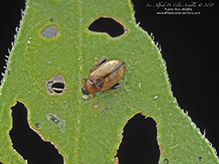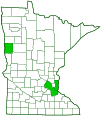potato flea beetle
(Psylliodes affinis)
Conservation • Description • Habitat • Ecology • Distribution • Taxonomy
Conservation Status |
|
|||||||
| IUCN Red List | not listed |
|||||||
| NatureServe | NNR - Unranked |
|||||||
| Minnesota | not listed |
|||||||
Description |
||
Psylliodes affinis is one of two beetles that are widely known by the same common name “potato flea beetle”. The other is Epitrix cucumeris. Both occur in Minnesota. Potato flea beetle (Psylliodes affinis) is a small, exotic, flea beetle. It is native to Europe and northern Asia. It is most common in England and Central Europe. It was accidentally introduced into North America in the 1960s. The first report of it in North America is from Albany, New York in July 1968. Since its introduction it has spread slowly but gradually westward. It was first detected in Minnesota in 1983. It now occurs in the east from Maine to Virginia, west to Minnesota, and in the Pacific Northwest in Washington and northern Oregon. In southern Canada it occurs from Nova Scotia to Ontario and in British Columbia. It is not common anywhere in North America. It is considered adventive, not naturalized, meaning that its numbers cannot be sustained without periodic population boosts from Europe. Psylliodes affinis hosts are plants in the nightshade (Solanaceae) family. It is a potential pest of potato crops, but to date it has not been collected on any economically important plants. Early stage (instar) larvae feed internally on the roots. Final instar larvae feed externally on the roots. Adults are found from April to September anywhere the host plants are found, including prairies, meadows, open woodlands, wetland margins, gardens, and roadsides. They feed on the leaves. Adults are very small, just 1⁄16″to ⅛″ (2.0 to 2.9 mm) in length. The body is egg-shaped. Males are narrower than females. The head is usually black, sometimes dark brown. It is visible from above. The upper part of the head (vertex) is almost flat and is very finely pitted (punctate). The eyes are large and convex. The antennae have 11 segments. They are pale brown and become darker toward the tip. The exoskeletal plate (pronotum) covering the front part of the body (prothorax) is wider than long, widest at the rear and narrowed toward the front. The front margin is rounded, the front corners are broadly rounded, and the rear corners are sharply angled. The lateral margins are narrowly flattened. The surface is moderately punctate, the punctures moderately deep. It is variable in color, orangish or reddish, and medium dark or very dark. The plate between the wing bases (scutellum) is triangular and very small but visible. The hardened wing covers (elytra) are widest in front and gradually narrowed to a rounded rear margin. They are mostly yellowish with a large, triangular, dark area below the scutellum, and a dark area at the tip. The inner margin (suture) is dark brown or black. The surface is grooved, and each groove is strongly punctured. The lateral margins are narrowly flattened. The legs are mostly pale brown to yellow. The third segment (femur) on the hind legs is greatly enlarged and black or dark brown. The last part of each leg (tarsus), corresponding to the foot, has five segments. The fourth segment is very short and is concealed within the broadened tip of the third segment, making the tarsus appear to have only four segments. There is a pair of equally sized claws at the tip of the tarsus. |
||
Size |
||
Total length: 1⁄16″to ⅛″ (2.0 to 2.9 mm) |
||
Similar Species |
||
Habitat |
||
Anywhere the host plants are found, including prairies, meadows, open woodlands, wetland margins, gardens, and roadsides |
||
Ecology |
||
Season |
||
April to September |
||
Behavior |
||
|
||
Life Cycle |
||
Adults overwinter in grass tussocks or vegetative litter. They emerge in April or May. Females bury small groups of eggs in the soil near a host stem. |
||
Larva Food |
||
Roots of plants in the nightshade (Solanaceae) family |
||
Adult Food |
||
Leaves of plants in the nightshade (Solanaceae) family |
||
Distribution |
||||
|
Sources |
|||
| 7/28/2023 | ||||
Occurrence |
||||
Uncommon |
||||
Taxonomy |
|||
Order |
Coleoptera (Beetles) | ||
Suborder |
Polyphaga (Water, Rove, Scarab, Long-horned, Leaf, and Snout Beetles) | ||
Infraorder |
Cucujiformia | ||
Superfamily |
Chrysomeloidea (leaf beetles and allies) | ||
Family |
Chrysomelidae (leaf beetles) | ||
Subfamily |
Galerucinae (skeletonizing leaf and flea beetles) | ||
Tribe |
Alticini (flea beetles) | ||
Genus |
Psylliodes | ||
Synonyms |
|||
|
|||
Common Names |
|||
potato flea beetle |
|||
Glossary
Elytra
The hardened or leathery forewings of beetles used to protect the fragile hindwings, which are used for flying. Singular: elytron.
Femur
On insects and arachnids, the third, largest, most robust segment of the leg, coming immediately before the tibia. On humans, the thigh bone.
Pronotum
The exoskeletal plate on the upper side of the first segment of the thorax of an insect.
Prothorax
The first (forward) segment of the thorax on an insect, bearing the first pair of legs but not wings.
Punctate
Dotted with pits (punctures), translucent sunken glands, or colored spots of pigment.
Scutellum
The exoskeletal plate covering the rearward (posterior) part of the middle segment of the thorax in some insects. In Coleoptera, Hemiptera, and Homoptera, the dorsal, often triangular plate behind the pronotum and between the bases of the front wings. In Diptera, the exoskeletal plate between the abdomen and the thorax.
Vertex
The upper surface of an insect’s head.
Visitor Photos |
|||||
Share your photo of this insect. |
|||||
| This button not working for you? Simply email us at info@MinnesotaSeasons.com. Attach one or more photos and, if you like, a caption. |
|||||
Alfredo Colon |
|||||
 |
|||||
MinnesotaSeasons.com Photos |
|||||
|
|||||

Slideshows |
||

Visitor Videos |
|||
Share your video of this insect. |
|||
| This button not working for you? Simply email us at info@MinnesotaSeasons.com. Attach a video, a YouTube link, or a cloud storage link. |
|||
Other Videos |
|||

Created: 7/28/2023
Last Updated:


